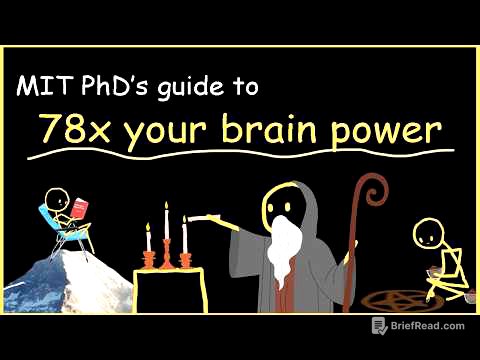TLDR;
This video provides a comprehensive guide on effective study techniques for college students. It emphasizes the importance of breaking up study sessions, creating a dedicated study environment, and actively engaging with the material. The lecture also covers strategies for memorizing facts and understanding concepts, highlighting the use of mnemonics and study groups.
- Break study sessions into manageable chunks with short breaks.
- Create a dedicated study environment to minimize distractions.
- Actively engage with the material by reciting, teaching, or writing in your own words.
- Utilize mnemonics to aid in memorization of facts.
- Prioritize sleep to facilitate memory consolidation.
Introduction: Key Study Strategies [0:01]
The speaker begins by stating that they will focus on the most important study tips due to time constraints. The initial question posed to the audience is how long a typical college freshman can effectively study before their concentration wanes.
Optimal Study Time: The 25-30 Minute Rule [0:09]
The speaker discusses a study from the University of Michigan, which found that most students can only focus for 25-30 minutes before their attention drifts. This is also true for lectures, where students often lose focus after about 25 minutes. Despite this, classes are typically 50 minutes long, suggesting that much of the learning happens in the first half-hour.
The Case of Janette: Why More Isn't Always Better [2:32]
The speaker shares an anecdote about a freshman named Janette who went from a D average to studying six hours a night, five nights a week, but ended up failing every class. This illustrates that simply studying more is not always helpful and can sometimes worsen performance. The speaker uses a graph to explain that after about 30 minutes, Janette's study efficiency plummeted, but she continued to sit at her desk, associating studying with pain and misery.
The Importance of Breaks and Reinforcement [5:14]
The speaker emphasizes the importance of taking breaks when you start to lose focus. A short, 5-minute break can recharge your batteries and allow you to return to studying with nearly 100% efficiency. These breaks should involve doing something enjoyable as a reward for studying. The speaker also suggests planning something special to do after your study time is complete to reinforce the positive association with studying.
Creating a Dedicated Study Environment [10:15]
The speaker discusses the importance of having a dedicated study space, noting that most students study in their bedrooms, which can be problematic due to the primary function of a bedroom being sleep. A study at the University of Hawaii found that students struggled to get into studying because dorm rooms are multi-purpose spaces. The speaker suggests using a "study lamp" to create a cue for studying, turning the desk away from the bed, and removing food cues when studying in the kitchen or dining area.
Active Learning vs. Rote Memorization [19:50]
The speaker contrasts active learning with rote memorization, explaining that rote memorization involves reading or saying something over and over without truly understanding it. While it can work for some, it is not the most efficient method for most college students. Active learning involves understanding the concept and being able to put it in your own words.
Understanding Concepts: Ontogeny Recapitulates Phylogeny [23:32]
The speaker uses the example of "ontogeny recapitulates phylogeny" to illustrate the importance of understanding concepts. By breaking down the phrase and explaining its meaning, the speaker demonstrates how to make a complex idea understandable. The speaker also conducts a memory task to show how meaningful information is easier to remember than random letters.
Meaningfulness and Study Groups [31:09]
The speaker defines meaningful information as something that relates to what you already know, fitting into an existing "file system" in your brain. Study groups are presented as a valuable tool for making information more meaningful, as other students can offer explanations and insights that the instructor may not have considered.
The Pitfalls of Highlighting and the Importance of Sleep [33:54]
The speaker critiques the common practice of highlighting textbooks, arguing that it often leads to recognizing information rather than truly knowing it. To test if you really know the material, look away and try to explain it in your own words. The speaker also emphasizes the importance of getting adequate sleep, as REM sleep is crucial for consolidating memories and making learning permanent.
Note-Taking and Seeking Help [39:05]
The speaker stresses the importance of taking notes and expanding on them immediately after class to flesh out the details. If you miss something, ask a classmate or the instructor for clarification. Instructors want students to succeed and are happy to provide additional explanations.
Active Recitation and Textbook Strategies [41:20]
The speaker recommends active recitation, such as teaching the material to someone else or even an empty chair, as a way to reinforce learning. The speaker also discusses the SQ3R method (Survey, Question, Read, Recite, Review) for effectively using textbooks.
Mnemonics for Memorizing Facts [47:33]
The speaker introduces mnemonics as a tool for memorizing facts, covering acronyms, coined sayings, and interacting images. Examples include "ROYGBIV" for the colors of the rainbow, "SAME" (Sensory Afferent, Motor Efferent), and using "radio" to remember that the right atrium is deoxygenated. The speaker emphasizes that interacting images, especially weird ones, can be particularly effective.
Interacting Images and Nutrition Facts [54:48]
The speaker provides examples of using interacting images to remember nutrition facts, such as associating "car" with 4 wheels to remember that carbohydrates have 4 calories per gram, and picturing "fat cats" with 9 lives to remember that fat has 9 calories per gram. The speaker concludes by encouraging the audience to use these techniques to improve their study habits and academic performance.









